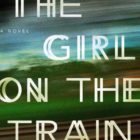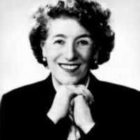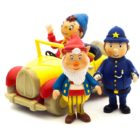 It’s Squib Saturday. Time to share the best, most interesting (or most entertaining, or most outrageous) tidbit of information I’ve gleaned from all the stuff I’ve read this week. Today: Author of “The Girl on the Train” Admits to Low-Brow Taste in Books as a Child
It’s Squib Saturday. Time to share the best, most interesting (or most entertaining, or most outrageous) tidbit of information I’ve gleaned from all the stuff I’ve read this week. Today: Author of “The Girl on the Train” Admits to Low-Brow Taste in Books as a Child
 I was happy to read recently that Paula Hawkins, the British best-selling thriller author of The Girl on the Train, and I shared a guilty pleasure as children. With the U.S. opening of the movie based on the book a week ago, the New York Times commemorated the occasion by featuring Paula in its By the Book segment. When asked what kind of reader she was as a child, Paula replied, “Not a particularly high-brow one. I read a great deal of Enid Blyton.”
I was happy to read recently that Paula Hawkins, the British best-selling thriller author of The Girl on the Train, and I shared a guilty pleasure as children. With the U.S. opening of the movie based on the book a week ago, the New York Times commemorated the occasion by featuring Paula in its By the Book segment. When asked what kind of reader she was as a child, Paula replied, “Not a particularly high-brow one. I read a great deal of Enid Blyton.”
Devouring Blyton Books
That’s not a name that will be very familiar to readers in the U.S. However, Enid Blyton (1897-1968) was one of the most prolific authors of children’s books ever. And, one of the most denigrated. By teachers anyway. Her books were criticized for having no literary merit. I paid no attention to the criticisms, and devoured them. As I am sure Paula did.
Transgender Protagonist?
 On summer vacations, I read three of them a day, returning to our local library daily for more Enid Blyton. The books were easy to read, and there were plenty of them. At one point, Blyton was writing 50 books a year. The Secret Seven and The Famous Five series were about kids/pre-teens who were child detectives, roaming their local communities and the British countryside (without parents) and solving mysteries. The five of the Famous Five included a mutt, and a girl, Georgina, who might well be the first transgender protagonist in the history of children’s fiction since she looked like a boy, dressed like a boy, insisted on being called George, and was constantly battling to prove “she was as good as any boy.”
On summer vacations, I read three of them a day, returning to our local library daily for more Enid Blyton. The books were easy to read, and there were plenty of them. At one point, Blyton was writing 50 books a year. The Secret Seven and The Famous Five series were about kids/pre-teens who were child detectives, roaming their local communities and the British countryside (without parents) and solving mysteries. The five of the Famous Five included a mutt, and a girl, Georgina, who might well be the first transgender protagonist in the history of children’s fiction since she looked like a boy, dressed like a boy, insisted on being called George, and was constantly battling to prove “she was as good as any boy.”
Mean Girls
 In Blyton’s Adventure series (Castle of Adventure, River of, Circus of,) the kids went international and solved mysteries in Europe. Blyton also wrote Malory Towers, a series set in a girls’ boarding school complete with its own clique of “Mean Girls” — and midnight feasts in the dorm rooms. And, of course, there was the starter Noddy series about a little wooden elf who drove a car around Toyland, and gave rides to his friends Mr. Big Ears, Mr. Plod, the friendly policeman, and Mr. Golly, who lived in Golly Town with other golliwogs or gollies (a type of rag doll with a black face.)
In Blyton’s Adventure series (Castle of Adventure, River of, Circus of,) the kids went international and solved mysteries in Europe. Blyton also wrote Malory Towers, a series set in a girls’ boarding school complete with its own clique of “Mean Girls” — and midnight feasts in the dorm rooms. And, of course, there was the starter Noddy series about a little wooden elf who drove a car around Toyland, and gave rides to his friends Mr. Big Ears, Mr. Plod, the friendly policeman, and Mr. Golly, who lived in Golly Town with other golliwogs or gollies (a type of rag doll with a black face.)
No More Gollies
 In more recent decades, Blyton grew further out of favor and was criticized for being elitist, sexist, racist and xenophobic. Arguably, it’s difficult to imagine a Mr. Big Ears (labelled by his flawed facial characteristic) or a Mr. Plod ( a friendly cop) stepping easily into the pages of any children’s book today. Never mind, a children’s book with characters called golliwogs (long considered a derogatory name for black people in the U.K.) Indeed, when Enid Blyton’s granddaughter, Sophie Smallwood, wrote a new Noddy adventure, in 2009, it was without any mention of Golly Town or golliwogs notwithstanding the fact that Mr. Golly was portrayed by Blyton as the owner of the garage in Toyland — and was therefore the book’s only entrepreneur. By that time however, gollies which had once been popular nursery toys in the U.K. were considered racially insensitive and were no longer acceptable.
In more recent decades, Blyton grew further out of favor and was criticized for being elitist, sexist, racist and xenophobic. Arguably, it’s difficult to imagine a Mr. Big Ears (labelled by his flawed facial characteristic) or a Mr. Plod ( a friendly cop) stepping easily into the pages of any children’s book today. Never mind, a children’s book with characters called golliwogs (long considered a derogatory name for black people in the U.K.) Indeed, when Enid Blyton’s granddaughter, Sophie Smallwood, wrote a new Noddy adventure, in 2009, it was without any mention of Golly Town or golliwogs notwithstanding the fact that Mr. Golly was portrayed by Blyton as the owner of the garage in Toyland — and was therefore the book’s only entrepreneur. By that time however, gollies which had once been popular nursery toys in the U.K. were considered racially insensitive and were no longer acceptable.
I prefer to remember Enid Blyton’s books more fondly. Her name was synonymous with fast-paced plots and page-turners — hallmarks which Paula Hawkins has obviously mastered in her own bestseller, and which one day maybe I will too.
Photo Credits : top and bottom photos bigstockphoto.com